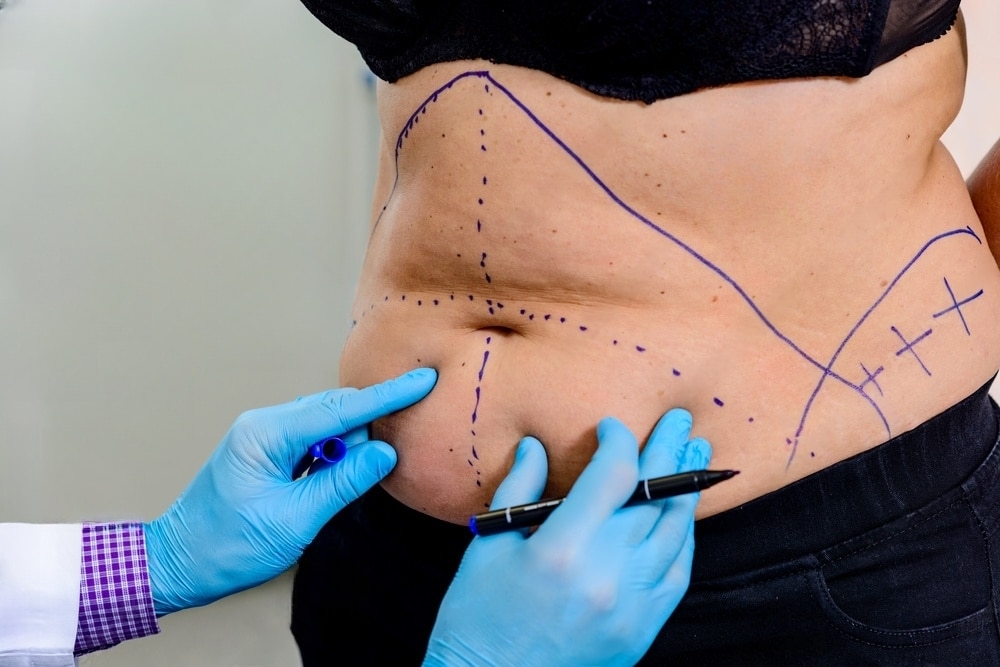Tummy Tuck
- April 19, 2023
Discover the benefits of a tummy tuck, a surgical procedure that removes excess skin and fat while tightening abdominal muscles for a flatter, firmer abdomen. Learn about the process, ideal candidates, and potential risks.
AVERAGE COST
$4.500 to $8,000
PROCEDURE TIME
2 to 4 Hours
BACK TO WORK
2 to 6 Weeks
FULL RECOVERY
4 to 6 Weeks
Get In Touch
We will contact you as soon as possible!









What is a Tummy Tuck?
A tummy tuck, also known as abdominoplasty, is a surgical procedure that aims to improve the appearance of the abdominal area by removing excess skin and fat and tightening the underlying abdominal muscles. This procedure is commonly performed on individuals who have experienced significant weight loss, pregnancy, or aging, which can result in sagging skin and weakened abdominal muscles.
The surgery typically involves the following steps:
- The surgeon makes a horizontal incision between the pubic hairline and belly button, sometimes extending to the sides of the abdomen.
- The skin is separated from the underlying abdominal muscles.
- The abdominal muscles are tightened, typically by suturing them together.
- Excess skin and fat are removed.
- The remaining skin is pulled down and sutured in place.
- In some cases, the belly button may be repositioned to match the new contour of the abdomen.
A tummy tuck can result in a flatter, firmer abdomen and improved body contour. However, it’s important to note that it is a major surgery with potential risks and complications, such as infection, bleeding, scarring, and anesthesia-related issues. It’s crucial to consult with a board-certified plastic surgeon to discuss your goals, medical history, and risks associated with the procedure to determine if a tummy tuck is appropriate for you.
What is the process of Tummy Tuck surgery?
The process of tummy tuck surgery, or abdominoplasty, involves several steps to remove excess skin and fat and tighten the abdominal muscles, resulting in a more toned and contoured abdomen. Here is an overview of the procedure:
Prior to the surgery, you will have a consultation with a board-certified plastic surgeon to discuss your goals, medical history, and any potential risks or complications associated with the procedure. The surgeon will assess your abdomen, recommend the appropriate type of tummy tuck, and provide preoperative instructions.
On the day of the surgery, you will be given anesthesia to ensure your comfort during the procedure. This can be general anesthesia or intravenous sedation, depending on the surgeon’s recommendation and the scope of the surgery.
The surgeon will make a horizontal incision between the pubic hairline and the belly button, sometimes extending to the sides of the abdomen. The incision’s length and shape depend on the amount of excess skin to be removed. In some cases, a second incision around the navel may be necessary to remove excess skin in the upper abdomen.
The skin is separated from the underlying abdominal muscles, which are then tightened by suturing them together. This step helps to create a firmer abdominal wall and a narrower waistline.
Excess skin and fat are removed, and the remaining skin is pulled down and sutured in place. If necessary, the belly button will be repositioned to match the new contour of the abdomen.
The incisions are closed using sutures, skin adhesives, or clips. Drains may be placed under the skin to collect any excess fluid or blood, and a compression garment is often applied to minimize swelling and support the healing tissues.
The recovery period for a tummy tuck can vary, but most patients can return to work and daily activities within 2-4 weeks. It is essential to follow your surgeon’s postoperative care instructions, which may include avoiding heavy lifting, wearing a compression garment, and attending follow-up appointments.
It is important to remember that a tummy tuck is a major surgery with potential risks and complications. Consulting with a board-certified plastic surgeon and following their recommendations can help ensure a safe and successful procedure.
Are there any non-surgical alternatives for Tummy Tucks?
Yes, there are non-surgical alternatives to tummy tucks that can help improve the appearance of the abdominal area. These alternatives typically target excess fat and skin tightening, although they may not provide the same degree of muscle tightening or contouring as a surgical tummy tuck. Some non-surgical alternatives include:
CoolSculpting: CoolSculpting is a non-invasive fat reduction technique that uses controlled cooling to eliminate stubborn fat cells. It is FDA-approved for treating multiple areas, including the abdomen. Although it can help reduce fat, it does not address excess skin or muscle laxity.
Radiofrequency treatments: Radiofrequency devices, such as Thermage or Exilis, use heat energy to stimulate collagen production and tighten the skin. These treatments can improve skin tone and texture but are generally less effective in addressing significant skin laxity or muscle tightening.
Ultrasound therapy: Ultrasound-based treatments, like Ultherapy or Liposonix, use focused ultrasound energy to heat and stimulate collagen production in the skin’s deeper layers, promoting skin tightening. Like radiofrequency treatments, they can help improve skin tone and texture but may not be as effective for significant skin laxity or muscle issues.
Laser treatments: Non-ablative laser treatments, such as SculpSure, can help reduce fat and promote skin tightening by heating the targeted area. These treatments are less invasive than surgery but may require multiple sessions to achieve the desired results.
Injectable treatments: Some injectable treatments, such as Kybella, can help reduce localized fat deposits. Kybella is FDA-approved for treating submental fullness (double chin) but has been used off-label in other areas, including the abdomen. It is not designed to address skin laxity or muscle tightening.
It’s essential to have realistic expectations when considering non-surgical alternatives to tummy tucks. While these treatments can offer some improvements, they generally do not provide the same level of correction as a surgical tummy tuck. Consulting with a board-certified plastic surgeon or dermatologist can help determine the most appropriate treatment option for your specific needs and goals.
Are there different techniques used for Tummy Tuck surgery?
Yes, there are different techniques used for tummy tuck surgery, depending on the patient’s specific needs, goals, and the extent of correction required. The main types of tummy tuck techniques are:
Full (or traditional) tummy tuck: This is the most common technique, addressing the entire abdominal area. It involves a horizontal incision between the pubic hairline and the belly button, and sometimes, a second incision around the navel. The surgeon tightens the abdominal muscles, removes excess skin and fat, and repositions the belly button if needed. This technique is suitable for patients with significant skin laxity and weakened abdominal muscles.
Mini tummy tuck: A less invasive option, the mini tummy tuck targets the lower abdomen below the belly button. It requires a smaller incision above the pubic area and does not involve repositioning the belly button. This technique is ideal for patients with mild to moderate skin laxity and minor muscle separation in the lower abdomen.
Extended tummy tuck: This technique is similar to a full tummy tuck but involves a longer incision that extends around the flanks or hips. It addresses not only the abdominal area but also the flanks and lower back, removing more extensive amounts of excess skin and fat. This procedure is suitable for patients with significant skin laxity or those who have experienced massive weight loss.
Fleur-de-lis tummy tuck: This technique is designed for patients with significant skin laxity in both the vertical and horizontal directions, often following massive weight loss. It involves a vertical incision down the center of the abdomen in addition to the horizontal incision, creating a fleur-de-lis shape. This allows for the removal of more skin and provides greater contouring.
Circumferential (or belt lipectomy) tummy tuck: This technique combines a tummy tuck with a lower body lift, addressing the abdomen, flanks, and lower back in a single procedure. It involves an incision that encircles the entire waistline, allowing the surgeon to remove excess skin and fat and lift the buttocks and outer thighs. This procedure is often recommended for patients who have experienced massive weight loss and have significant skin laxity around their entire midsection.
The choice of technique depends on the patient’s specific needs, anatomy, and desired outcomes. A board-certified plastic surgeon can evaluate your abdomen and recommend the most appropriate tummy tuck technique for your situation during a consultation.
How does Tummy Tuck surgery affect overall body proportions?
Tummy tuck surgery, or abdominoplasty, can significantly affect overall body proportions by improving the appearance and contour of the abdominal area. Some of the ways a tummy tuck can influence body proportions are:
Waistline reduction: By tightening the abdominal muscles and removing excess skin and fat, a tummy tuck can create a more defined waistline, resulting in an hourglass figure for women or a more tapered torso for men.
Flatter abdomen: The removal of excess skin and fat, along with muscle tightening, leads to a flatter and firmer abdomen, giving the body a more balanced and toned appearance.
Improved posture: Tightening the abdominal muscles can provide better support for the spine, potentially improving posture and reducing lower back pain in some cases.
Enhanced body contour: In some tummy tuck techniques, such as the extended or circumferential tummy tuck, excess skin and fat are removed from the flanks or lower back, enhancing the overall body contour and improving the appearance of the waist, hips, and buttocks.
Clothing fit: A tummy tuck can make clothes fit better and more comfortably, as the newly contoured abdomen allows for a more even distribution of fabric and a smoother silhouette.
While a tummy tuck can significantly improve overall body proportions, it’s essential to have realistic expectations and understand that the procedure primarily targets the abdominal area. A tummy tuck may be combined with other procedures, such as liposuction, breast augmentation, or thigh lift, to address additional areas of concern and further enhance body proportions. A board-certified plastic surgeon can help determine the most suitable approach to achieve your desired results.
Is there an age limit for undergoing Tummy Tuck surgery?
There is no specific age limit for undergoing tummy tuck surgery. However, several factors can influence a patient’s suitability for the procedure. The most important factor is the patient’s overall health, as a tummy tuck is a major surgery with potential risks and complications.
Ideal candidates for tummy tuck surgery should:
Be in good overall health: Patients should be free of any serious medical conditions that could increase the risk of complications during or after surgery. Chronic health issues such as diabetes, heart disease, or lung problems may affect a patient’s eligibility for a tummy tuck.
Have realistic expectations: It’s important to understand the potential outcomes of a tummy tuck and have realistic expectations regarding the results and recovery process.
Be at a stable weight: Patients should be close to their ideal body weight before undergoing a tummy tuck, as significant weight fluctuations after surgery can affect the long-term results.
Be a non-smoker or willing to quit smoking: Smoking can increase the risk of complications and negatively impact the healing process. Surgeons typically recommend that patients quit smoking for several weeks before and after surgery.
Have completed childbearing (for women): Pregnancy can stretch the abdominal muscles and skin, potentially reversing the results of a tummy tuck. Women considering a tummy tuck should ideally wait until they have finished having children.
While there is no strict age limit, older patients should be aware that age can affect the body’s ability to heal and the skin’s elasticity, potentially impacting the results and recovery process. A thorough evaluation by a board-certified plastic surgeon is essential to determine if a tummy tuck is appropriate for an individual, considering their age, health, and personal goals.
Can a Tummy Tuck surgery be reversed or adjusted if complications arise or the patient is unsatisfied with the results?
While it is not possible to fully reverse a tummy tuck, certain complications or unsatisfactory results can be addressed or improved through revision surgery. The specific approach to revision surgery depends on the issues that need to be addressed and the extent of the adjustments required. Some common reasons for revision surgery include:
Unsatisfactory results: If the patient is unhappy with the initial results of the tummy tuck due to uneven contours, residual skin laxity, or insufficient muscle tightening, a revision surgery can be performed to make adjustments and achieve the desired outcome.
Complications: In the event of complications such as infection, wound healing issues, or the development of seromas (fluid collections) or hematomas (blood collections), a surgeon may need to perform additional procedures to address these issues and ensure proper healing.
Scarring: If the patient develops excessive or unsightly scarring, revision surgery may be considered to improve the appearance of the scars. Non-surgical treatments, such as silicone gel sheeting, steroid injections, or laser therapy, can also be employed to minimize scarring.
Changes in body shape: If a patient experiences significant weight fluctuations or becomes pregnant after a tummy tuck, the results may be compromised. In such cases, a second tummy tuck or additional body contouring procedures may be necessary to restore the desired appearance.
It is important to have realistic expectations about the results of a tummy tuck and understand that revision surgery may be needed in some cases. Choosing an experienced, board-certified plastic surgeon and following their preoperative and postoperative instructions can minimize the risk of complications and increase the likelihood of achieving satisfactory results. If a patient is unhappy with the outcome of their tummy tuck, they should discuss their concerns with their surgeon to determine the best course of action.
How does the psychological well-being of a patient impact their experience with Tummy Tuck surgery?
The psychological well-being of a patient can significantly impact their experience with tummy tuck surgery, affecting their expectations, recovery, and overall satisfaction with the procedure. Here are some ways in which psychological well-being can influence a patient’s tummy tuck experience:
Expectations: A patient with a healthy psychological outlook will typically have realistic expectations about the results of a tummy tuck, understanding that the procedure can improve their body contours but may not necessarily lead to perfection or solve all their self-image concerns.
Emotional preparedness: A patient who is emotionally stable and psychologically prepared for surgery is more likely to cope better with the physical and emotional stresses associated with the procedure and the recovery process.
Recovery: Psychological well-being can affect a patient’s ability to cope with postoperative pain, discomfort, and temporary limitations in their daily activities. Patients who are emotionally resilient may have an easier time adapting to these challenges and may experience a smoother recovery.
Satisfaction with results: A patient’s psychological well-being can impact their overall satisfaction with the results of the tummy tuck. Those with a positive self-image and realistic expectations are more likely to be satisfied with the outcome and have an improved quality of life following the procedure.
Body image: A tummy tuck can significantly improve a patient’s body image and self-confidence. However, it’s essential to recognize that surgery may not resolve all body image concerns or psychological issues related to appearance. In some cases, additional psychological support or counseling may be beneficial.
Before undergoing a tummy tuck, it’s important for patients to discuss their psychological well-being, expectations, and concerns with their plastic surgeon. The surgeon can help determine if the patient is a good candidate for the procedure and provide guidance on how to achieve the best possible outcome and maintain a positive psychological outlook throughout the process.
Are there any advancements in the field of Tummy Tuck surgery?
While the fundamental principles of tummy tuck surgery have remained relatively consistent over the years, there have been advancements and refinements in techniques, technology, and patient care that have improved the safety, recovery, and results of the procedure. Some of the recent advancements in tummy tuck surgery include:
Enhanced surgical techniques: Surgeons are continually refining their techniques to minimize scarring, reduce complications, and improve the overall contouring and aesthetic results of the tummy tuck. Some of these refinements include the use of progressive tension sutures or drainless tummy tucks to reduce the risk of seroma formation and minimize tension on the incision, leading to better scarring.
Liposuction integration: Combining liposuction with a tummy tuck, also known as lipoabdominoplasty, has become more common to achieve better contouring and a more natural, sculpted appearance. This approach allows surgeons to address both excess skin and fat deposits in a single procedure.
Enhanced pain management: Innovations in pain management, such as the use of long-acting local anesthetics like Exparel, have helped to improve patient comfort during the recovery process. These medications can significantly reduce postoperative pain, minimizing the need for narcotic pain relievers and potentially speeding up recovery.
Improved patient care and recovery protocols: Surgeons have developed more comprehensive preoperative and postoperative care protocols to optimize patient outcomes and minimize complications. These include detailed instructions on nutrition, wound care, activity restrictions, and compression garments, as well as the use of evidence-based practices for reducing the risk of blood clots and infections.
Non-surgical alternatives: While not a direct advancement in tummy tuck surgery, the development of non-surgical body contouring treatments, such as CoolSculpting, radiofrequency, and ultrasound therapies, has expanded the range of options available to patients seeking to improve their abdominal appearance. These non-invasive treatments can provide modest improvements in skin tightening and fat reduction, although they generally do not achieve the same level of correction as a surgical tummy tuck.
The field of plastic surgery is constantly evolving, and tummy tuck surgery will likely continue to benefit from advancements in techniques, technology, and patient care in the future. It’s essential for patients to choose a board-certified plastic surgeon who stays up-to-date with the latest advancements and best practices to ensure the safest and most effective results.
Can a Tummy Tuck be combined with any other procedure?
Yes, a tummy tuck can be combined with other procedures to address multiple areas of concern and achieve more comprehensive results. Combining surgeries is sometimes referred to as a “mommy makeover” or body contouring surgery, depending on the specific combination of procedures. Some common procedures that can be combined with a tummy tuck include:
Liposuction: Liposuction can be performed in conjunction with a tummy tuck to remove stubborn fat deposits in the abdomen, flanks, hips, or other areas of the body. This combination, known as lipoabdominoplasty, can enhance the overall body contour and create a more sculpted appearance.
Breast surgery: Breast augmentation, breast lift (mastopexy), or breast reduction can be combined with a tummy tuck to address both the breasts and the abdomen simultaneously. This combination is common in a “mommy makeover” to help women restore their pre-pregnancy body shape.
Lower body lift: A tummy tuck can be part of a more extensive lower body lift procedure, which also addresses the flanks, hips, and buttocks. This is often performed on patients who have experienced significant weight loss and have excess skin in multiple areas of the body.
Thigh lift: A thigh lift can be combined with a tummy tuck to address excess skin and fat in the upper legs, further improving overall body proportions.
Arm lift: An arm lift (brachioplasty) can be performed alongside a tummy tuck to remove excess skin and fat in the upper arms, providing a more balanced and toned appearance.
It’s important to note that combining procedures can increase the complexity, duration, and recovery time of the surgery. The patient’s overall health, goals, and the surgeon’s recommendations will determine whether combining procedures is appropriate. A board-certified plastic surgeon can help you decide which combination of procedures is best suited for your individual needs and desired outcomes.
Who is a good candidate for Tummy Tuck surgery?
A candidate for tummy tuck surgery is typically someone who has excess skin and fat in the abdominal area, as well as weakened or separated abdominal muscles (diastasis recti). Ideal candidates for a tummy tuck should meet the following criteria:
Be in good overall health: Candidates should be free of any serious medical conditions that could increase the risk of complications during or after surgery. Chronic health issues such as diabetes, heart disease, or lung problems may affect a patient’s eligibility for a tummy tuck.
Have realistic expectations: It’s important to understand the potential outcomes of a tummy tuck and have realistic expectations regarding the results and recovery process.
Be at a stable weight: Patients should be close to their ideal body weight before undergoing a tummy tuck, as significant weight fluctuations after surgery can affect the long-term results.
Be a non-smoker or willing to quit smoking: Smoking can increase the risk of complications and negatively impact the healing process. Surgeons typically recommend that patients quit smoking for several weeks before and after surgery.
Have completed childbearing (for women): Pregnancy can stretch the abdominal muscles and skin, potentially reversing the results of a tummy tuck. Women considering a tummy tuck should ideally wait until they have finished having children.
Have excess skin and/or fat in the abdomen: Candidates should have a noticeable amount of excess skin and/or fat in the abdominal area, which is not responsive to diet and exercise.
Have weakened or separated abdominal muscles: A tummy tuck is most effective for patients with weakened or separated abdominal muscles, often caused by pregnancy, weight fluctuations, or aging.
A thorough evaluation by a board-certified plastic surgeon is essential to determine if a tummy tuck is appropriate for an individual, considering their age, health, and personal goals.
What are the long-term effects and potential complications of Tummy Tuck surgery?
Tummy tuck surgery, like any surgical procedure, carries some potential risks and complications. Although most patients experience successful outcomes, it’s essential to be aware of the long-term effects and potential complications.
Long-term effects:
Improved abdominal contour: The primary long-term effect of a tummy tuck is a flatter, firmer abdomen with a more defined waistline, which can lead to increased self-confidence and a better overall body image.
Permanent scarring: A tummy tuck will leave a permanent scar, typically located low on the abdomen, just above the pubic area, and extending from hip to hip. The scar’s appearance usually improves over time, but it will remain visible.
Potential need for revision surgery: Some patients may require revision surgery in the future due to dissatisfaction with the initial results, complications, or changes in body shape due to weight fluctuations or pregnancy.
Potential complications:
Infection: As with any surgery, there is a risk of infection. Proper postoperative care and hygiene are crucial to minimize this risk.
Bleeding and hematoma: Excessive bleeding or the formation of a hematoma (a collection of blood) can occur. In some cases, additional surgery may be needed to address this issue.
Seroma: A seroma is a buildup of fluid under the skin. It may require drainage or additional procedures to resolve.
Poor wound healing: Some patients may experience slow or poor wound healing, which can result in wider or more visible scarring.
Changes in skin sensation: Temporary or permanent changes in skin sensation, such as numbness or tingling, may occur in the abdominal area.
Unsatisfactory results: Some patients may be unhappy with the results of their tummy tuck due to uneven contours, residual skin laxity, or insufficient muscle tightening. Revision surgery may be needed to address these issues.
Blood clots: There is a risk of blood clots forming in the legs (deep vein thrombosis) or lungs (pulmonary embolism) after surgery. Following your surgeon’s instructions regarding early mobilization and the use of compression garments can help minimize this risk.
Anesthesia risks: As with any surgery requiring anesthesia, there are potential risks associated with the use of anesthesia, including adverse reactions or complications.
To minimize the risks and ensure the best possible outcome, it is essential to choose a board-certified plastic surgeon with experience in tummy tuck surgery and follow their preoperative and postoperative instructions carefully.
How successful and safe is Tummy Tuck surgery?
Tummy tuck surgery, when performed by a skilled and experienced board-certified plastic surgeon, is generally considered to be both successful and safe. The procedure has a high success rate in terms of patient satisfaction and improved body contour, with many patients reporting a significant improvement in their abdominal appearance, self-confidence, and overall quality of life.
As with any surgical procedure, there are inherent risks and potential complications associated with tummy tuck surgery. However, these risks can be minimized by carefully selecting a qualified surgeon, adhering to their preoperative and postoperative instructions, and maintaining realistic expectations about the results.
The safety of a tummy tuck can be maximized by:
Choosing a board-certified plastic surgeon: Ensuring that your surgeon has the appropriate training, experience, and certification in performing tummy tuck surgery is crucial for a safe and successful outcome.
Comprehensive preoperative evaluation: A thorough medical evaluation and discussion of your medical history, lifestyle factors, and expectations with your surgeon can help identify potential risks and ensure that you are a suitable candidate for the procedure.
Adherence to preoperative and postoperative instructions: Following your surgeon’s instructions regarding preoperative preparation, postoperative care, activity restrictions, and wound care can significantly reduce the risk of complications and promote a smooth recovery.
Open communication with your surgeon: Maintaining open communication with your surgeon before and after the procedure allows for the early identification and management of potential complications or concerns.
Maintaining a healthy lifestyle: A healthy lifestyle, including proper nutrition, regular exercise, and avoidance of smoking, can contribute to a successful surgery and long-lasting results.
While no surgical procedure is entirely without risk, tummy tuck surgery has a proven track record of safety and success when performed by an experienced, board-certified plastic surgeon. It’s essential to carefully consider your options, discuss your goals and concerns with your surgeon, and follow their recommendations to ensure the best possible outcome.
How much does Tummy Tuck surgery cost?
The cost of a tummy tuck surgery (abdominoplasty) can vary widely depending on several factors, such as the location of the surgery, the experience and qualifications of the surgeon, the extent of the procedure, and the facility fees. In the United States, the cost of a tummy tuck surgery typically ranges from $4,500 to $8,000, but it can be higher in some regions or for more complex procedures.
The cost of a tummy tuck can also vary depending on whether it’s a full or mini tummy tuck, and if it’s combined with other procedures such as liposuction or a breast surgery.
Keep in mind that the quoted cost for a tummy tuck may not include all the associated expenses, such as:
- Surgeon’s fee
- Anesthesia fees
- Hospital or surgical facility costs
- Medical tests and imaging
- Post-surgery garments
- Prescriptions for medication
- Postoperative care and follow-up appointments
When considering a tummy tuck, it’s essential to discuss the total cost of the procedure with your surgeon during the consultation. They should provide you with a detailed breakdown of all the fees and expenses involved.
It’s also important to remember that a tummy tuck is generally considered a cosmetic procedure, so it is not typically covered by health insurance. Some patients may choose to explore financing options or payment plans to help manage the cost of the surgery. When selecting a surgeon, it’s crucial to prioritize their qualifications, experience, and reputation rather than solely focusing on the cost of the procedure.
Tummy Tuck Financing
Financing a tummy tuck, also known as abdominoplasty, can make the procedure more affordable and accessible for many people. There are various options available to help you cover the cost of a tummy tuck, including medical loans, personal loans, credit cards, and payment plans offered by your surgeon or clinic. Here are some financing options to consider:
Medical loans: Some financial institutions and lenders offer loans specifically designed for medical procedures, including tummy tucks. These loans can have competitive interest rates and flexible repayment terms.
Personal loans: If you have a good credit score, you may be able to secure a personal loan from a bank, credit union, or online lender. Personal loans usually have fixed interest rates and repayment terms, which can make budgeting easier.
Credit cards: Some credit card companies offer promotional interest rates or rewards for medical expenses. If you can pay off the balance within the promotional period, this may be a cost-effective option. However, be cautious of high-interest rates if you cannot pay off the balance in time.
Payment plans: Some plastic surgeons and clinics offer in-house financing or payment plans for their patients. These plans allow you to pay for your procedure in installments, often with little or no interest. Be sure to discuss these options with your surgeon during your consultation.
Health savings accounts (HSAs) or flexible spending accounts (FSAs): If you have an HSA or FSA, you may be able to use the funds to pay for a portion of your tummy tuck. However, since tummy tucks are generally considered cosmetic procedures, they may not be eligible for HSA or FSA coverage. Check with your plan administrator to verify your eligibility.
Friends and family: You might consider asking for financial assistance from friends and family or setting up a crowdfunding campaign to help cover the cost of your tummy tuck.
It’s essential to research and compare financing options before deciding on the best choice for your situation. Be sure to consider factors like interest rates, repayment terms, and any additional fees. Additionally, consult with a financial advisor if you need assistance in determining the best financing option for you.
Does a Tummy Tuck surgery is covered by insurance?
In most cases, a tummy tuck (abdominoplasty) is considered a cosmetic procedure and is not covered by health insurance. Insurance companies typically only cover procedures that are deemed medically necessary, and tummy tucks are generally performed for aesthetic purposes.
However, there are certain circumstances where a tummy tuck may be considered medically necessary and could be covered by insurance:
Panniculectomy: If you have a large pannus (overhanging skin and fat) that causes chronic skin irritation, infections, or functional impairments, your insurance may cover a panniculectomy, which involves removing the excess skin and fat without tightening the abdominal muscles.
Abdominal hernia repair: In some cases, a tummy tuck may be performed in conjunction with a hernia repair. If the hernia repair is deemed medically necessary, your insurance might cover a portion of the tummy tuck.
Post-bariatric surgery: After significant weight loss following bariatric surgery, some patients may require a tummy tuck to remove excess skin and improve their quality of life. In these cases, insurance coverage may be possible, depending on your insurance policy and specific medical circumstances.
To determine if your insurance will cover a tummy tuck or a related procedure, it’s essential to review your policy and discuss your specific situation with your insurance provider. You should also consult with a board-certified plastic surgeon, who can help you understand your options and provide documentation to support your insurance claim if necessary.
How long does the Tummy Tuck surgery last?
The duration of a tummy tuck surgery can vary depending on the complexity of the procedure and the individual patient’s needs. On average, a tummy tuck surgery can take anywhere from 2 to 4 hours to complete.
There are different types of tummy tuck procedures, which can impact the surgery’s duration:
Mini tummy tuck: A mini tummy tuck, or partial abdominoplasty, is a less invasive procedure that focuses on the lower abdomen. It typically takes about 1 to 2 hours to complete.
Full tummy tuck: A full tummy tuck, or complete abdominoplasty, addresses both the upper and lower abdomen. It involves removing excess skin and fat, tightening the abdominal muscles, and repositioning the belly button. This procedure usually takes about 2 to 4 hours.
Extended tummy tuck: An extended tummy tuck is a more extensive surgery that addresses the abdomen and the flanks (love handles). It can take anywhere from 3 to 5 hours to complete.
Circumferential tummy tuck or body lift: This procedure addresses the entire midsection, including the front and back, and is typically performed on patients who have undergone significant weight loss. The surgery can take 4 to 6 hours or more, depending on the extent of the procedure.
These times are approximate and can vary based on factors such as the surgeon’s experience, the patient’s anatomy, and any additional procedures being performed simultaneously (such as liposuction). It’s important to discuss the specifics of your tummy tuck procedure with your plastic surgeon to get a better understanding of the expected duration.
How soon can I resume work after surgery?
The timeline for resuming work after a tummy tuck (abdominoplasty) surgery depends on various factors such as the extent of the procedure, your individual healing rate, and the type of work you do. Generally, patients can expect the following guidelines for returning to work:
Sedentary jobs: If your job involves minimal physical activity, such as desk work, you may be able to return to work within 2 to 3 weeks after surgery. It’s essential to listen to your body and not push yourself too hard during the initial recovery period.
Moderately physical jobs: If your job involves some physical activity or lifting, you may need to wait 4 to 6 weeks before returning to work. Your surgeon will provide guidance on when it’s safe to resume more strenuous activities.
Physically demanding jobs: If your job is physically demanding or involves heavy lifting, you may need to wait at least 6 weeks, or possibly longer, before resuming work. Consult with your surgeon for specific recommendations based on your individual circumstances and recovery progress.
It’s essential to follow your surgeon’s guidelines and recommendations for returning to work, as returning too soon can increase the risk of complications or prolong your recovery time. Make sure to discuss your job requirements and expectations with your surgeon during the consultation process, and keep them informed about your recovery progress to ensure a safe and smooth return to work.
What is the recovery time and post-operative care required for Tummy Tuck surgery?
Recovery time for tummy tuck surgery (abdominoplasty) can vary depending on the individual, the extent of the surgery, and the surgeon’s technique. Generally, most patients can expect a recovery period of around 4-6 weeks.
Here are some post-operative care guidelines to consider after tummy tuck surgery:
Pain management: Your surgeon will likely prescribe pain medication to help manage discomfort during the first few days. Follow their instructions for usage.
Compression garment: You may be required to wear a compression garment for several weeks to help reduce swelling and support your abdominal muscles during recovery.
Rest and activity: It’s important to rest during the first few days, but also to engage in light walking as soon as you feel able. This can help promote circulation and prevent blood clots. Gradually increase your activity level, but avoid strenuous exercise, heavy lifting, or activities that can strain your abdominal muscles for at least 6 weeks.
Incision care: Keep the incision area clean and dry. You may need to change the dressing as instructed by your surgeon. Look out for signs of infection, such as redness, increased pain, or discharge.
Sleeping position: Elevating your upper body and keeping your knees bent with a pillow can help reduce tension on the incision site and alleviate discomfort.
Swelling: Swelling is normal after surgery and may take several weeks to subside. Drinking plenty of water, avoiding salty foods, and using cold compresses may help reduce swelling.
Follow-up appointments: Attend all scheduled follow-up appointments with your surgeon to monitor your progress and address any concerns.
It’s important to remember that individual experiences may vary, and your recovery timeline and post-operative care instructions may be different. Always follow the guidance of your surgeon or healthcare team for the best outcome.
Tummy Tuck Recovery Tips
To ensure a smooth and successful recovery after a tummy tuck, follow these tips:
Adhere to your surgeon’s guidelines for post-operative care, including medications, wound care, and activity restrictions.
Have a friend or family member available to assist you during the initial recovery period, as you may need help with daily activities, childcare, or transportation to follow-up appointments.
Give yourself time to heal and avoid overexertion. Start walking as soon as possible, but avoid strenuous activities, heavy lifting, or exercise until your surgeon clears you.
Drink plenty of water to help flush out toxins, promote healing, and reduce constipation, which can be a side effect of pain medications.
Consume a healthy diet rich in protein, vitamins, and minerals to aid in your recovery. Include fruits, vegetables, lean proteins, and whole grains.
Keep your upper body elevated with pillows when resting or sleeping to help reduce swelling and discomfort.
Take prescribed pain medications as directed and use over-the-counter anti-inflammatory medications if recommended by your surgeon. Applying cold packs can also help alleviate swelling.
Wear the recommended compression garments to provide support, reduce swelling, and improve healing.
Watch for increased pain, redness, discharge, or fever, which could be signs of infection. Contact your surgeon if you notice any concerning symptoms.
Healing takes time, and it’s essential to have realistic expectations about the recovery process. Swelling can take several months to fully subside, and final results may not be visible for up to a year.
Smoking impairs healing and increases the risk of complications, while alcohol can interfere with medications and negatively affect your recovery.
Go to all scheduled follow-up appointments to ensure your recovery is progressing well and address any concerns with your surgeon.
Remember that every individual’s recovery process is different. Following these tips and your surgeon’s specific recommendations will help you achieve the best possible results from your tummy tuck surgery.
What to Expect Post Tummy Tuck Surgery
After a tummy tuck (abdominoplasty) surgery, it’s essential to know what to expect during the recovery process. Here are some common post-operative experiences and expectations:
Pain and discomfort: You may experience moderate pain and discomfort after the surgery, especially during the first few days. Your surgeon will prescribe pain medications to help manage the pain.
Swelling and bruising: Swelling and bruising are common after a tummy tuck and may take several weeks or even months to fully subside. Wearing a compression garment can help reduce swelling and provide support to the surgical area.
Drains: Your surgeon may place surgical drains to help remove excess fluid from the surgical site. These drains are typically removed within one to two weeks post-surgery.
Limited mobility: Your mobility may be limited in the initial days following surgery. You will be encouraged to walk as soon as possible to promote circulation and reduce the risk of blood clots, but avoid strenuous activities and heavy lifting for at least 4 to 6 weeks.
Healing of the incision: The incision site will take time to heal, and you will be given instructions on proper wound care, including cleaning and keeping the area dry.
Scar formation: Scarring is a normal part of the healing process. Your surgeon will advise you on scar management techniques to help minimize the appearance of scars over time.
Numbness: You may experience numbness or changes in sensation around the surgical area, which usually improve over time.
Follow-up appointments: Attend all follow-up appointments with your surgeon to monitor your progress, address any concerns, and ensure proper healing.
Gradual return to normal activities: Most patients can return to work and daily activities within 2 to 4 weeks, depending on the extent of the surgery and individual healing rates.
Final results: The final results of a tummy tuck may not be visible until the swelling has fully subsided and the tissues have settled, which can take up to a year.
Maintain a healthy lifestyle: To achieve long-lasting results, it’s crucial to maintain a healthy lifestyle with a balanced diet and regular exercise.
Keep in mind that every patient’s recovery process is unique, and your experience may differ from others. Following your surgeon’s post-operative instructions and recommendations will help ensure the best possible outcome from your tummy tuck surgery.
How long does it take to regain full mobility after undergoing Tummy Tuck surgery?
Regaining full mobility after a tummy tuck (abdominoplasty) can vary from person to person, depending on factors such as the extent of the surgery, individual healing rates, and adherence to post-operative care instructions. Generally, patients can expect the following timeline for regaining mobility:
First few days: Mobility will be limited during the initial days following surgery. You may experience discomfort, tightness, and difficulty standing fully upright. It’s crucial to start walking as soon as possible, even if it’s only short distances, to promote blood circulation and reduce the risk of blood clots.
1-2 weeks: Most patients can gradually increase their walking distances and perform light daily activities during this period. You may still experience some discomfort and tightness, so it’s essential to avoid strenuous activities or heavy lifting.
2-4 weeks: At this stage, many patients can return to work and resume most daily activities. You may still need to avoid heavy lifting, bending, or twisting movements. Your surgeon will provide guidance on when you can resume more vigorous physical activities.
4-6 weeks: By this time, most patients have regained full mobility and can gradually return to more strenuous activities, such as exercise and heavy lifting, as long as their surgeon approves.
6-12 weeks: In some cases, it may take up to 12 weeks or longer for patients to feel completely comfortable and regain their full range of motion, particularly if they have undergone an extensive tummy tuck or have experienced any complications during the healing process.
It’s essential to follow your surgeon’s post-operative instructions and recommendations for resuming activities, as pushing yourself too soon can lead to complications or prolong your recovery time. Always consult your surgeon before returning to more strenuous activities or exercise.
We Have Great Answers
Ask Us Anything
Tummy tuck surgery itself is performed under general anesthesia or local anesthesia with sedation, so you won’t feel pain during the procedure. However, it is common to experience pain, discomfort, and soreness in the days following the surgery. Your surgeon will prescribe pain medications to help manage post-operative pain and ensure your comfort during the recovery process. The intensity and duration of pain can vary from person to person, and it generally decreases as the healing process progresses.
Tummy tuck surgery, like any surgical procedure, carries some risks and potential complications. However, when performed by a skilled and experienced board-certified plastic surgeon, tummy tuck surgery is generally considered safe. To ensure the safest possible outcome, it’s crucial to discuss your medical history, expectations, and concerns with your surgeon during the consultation process. Your surgeon will evaluate your overall health, provide personalized recommendations, and take necessary precautions to minimize risks and complications.
Tummy tuck surgery provides long-lasting results by removing excess skin and fat and tightening the abdominal muscles. However, the permanence of the results can be influenced by factors such as significant weight fluctuations, pregnancy, and aging. To maintain the results of a tummy tuck, it’s essential to maintain a stable weight through a healthy diet and regular exercise. While a tummy tuck can provide lasting improvements, it cannot stop the natural aging process or completely prevent changes due to lifestyle factors.
